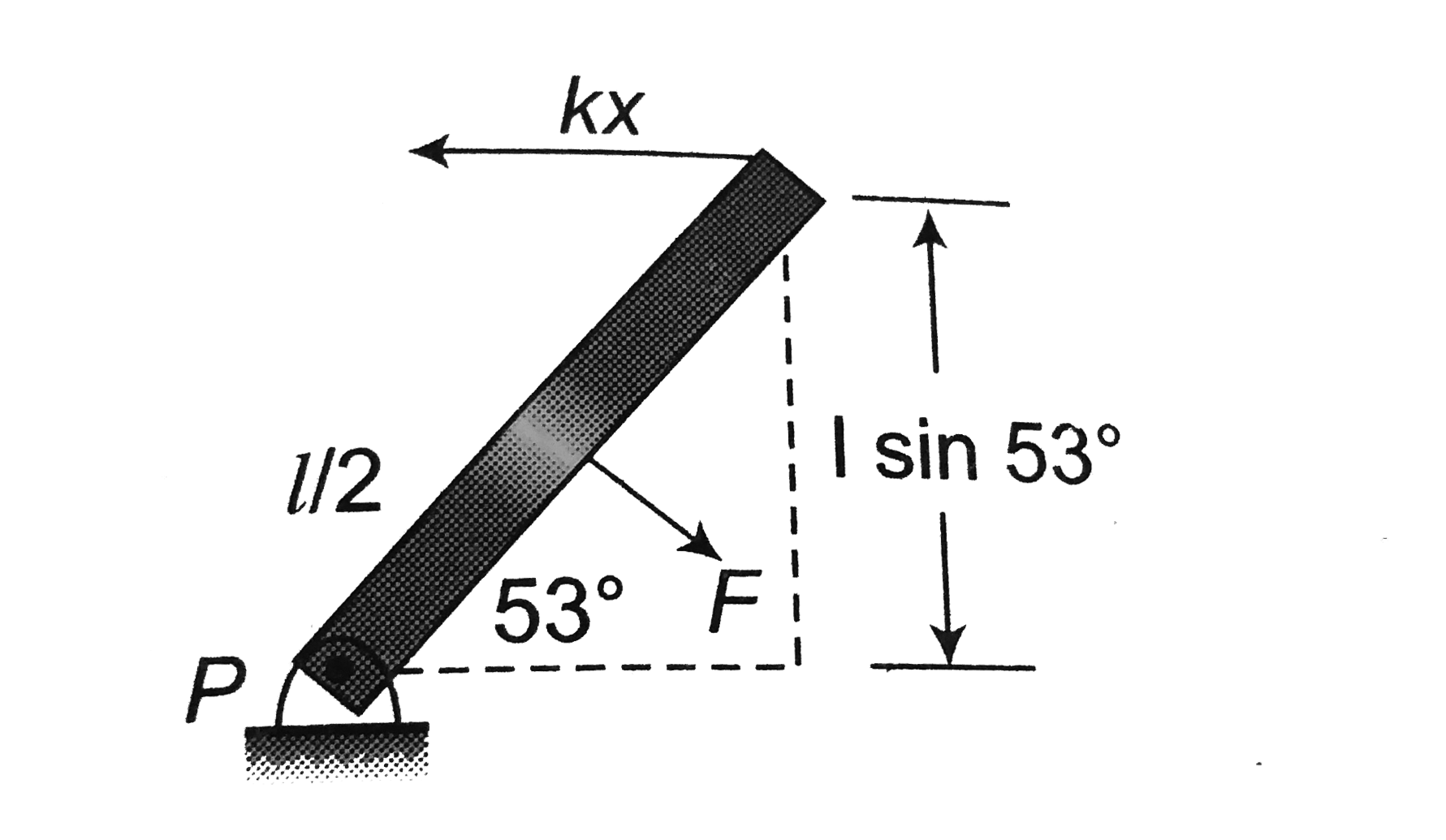A thin uniform rod with negligible mass and length l is attached to the floor by a frictionless hinge at point P. A horizontal spring with force constant k connects the other end to wall. The rod is in a uniform magnetic field B directed into the plane of paper. What is extension in spring in equilibrium when a current is passed through the rod in direction shown? Assuming spring to be in natural length initially and it remains perpendicular to wall always.

5ilB8k
3ilB8k
5ilB4k
5ilB6k
The correct Answer is:A
Magnetic force F=Bil
Net torque P is zero.

F12=kxlsin53∘⇒Bil2=kx×45
Topper's Solved these Questions
- SOURCE AND EFFECT OF MAGNETIC FIELDBook:A2ZChapter:SOURCE AND EFFECT OF MAGNETIC FIELDExercise:Magnetic Dipole
Explore 32 Videos
- SOURCE AND EFFECT OF MAGNETIC FIELDBook:A2ZChapter:SOURCE AND EFFECT OF MAGNETIC FIELDExercise:Magnetic Field Due To Current
Explore 44 Videos
- SOURCE AND EFFECT OF MAGNETIC FIELDBook:A2ZChapter:SOURCE AND EFFECT OF MAGNETIC FIELDExercise:Section D - Chapter End Test
Explore 30 Videos
- SEMICONDUCTOR ELECTRONICSBook:A2ZChapter:SEMICONDUCTOR ELECTRONICSExercise:EXERCISE
Explore 29 Videos
- WAVE OPTICSBook:A2ZChapter:WAVE OPTICSExercise:Section D - Chapter End Test
Explore 29 Videos
Similar Questions
A current carrying wire of length l is suspended horizontally by a spring of force constant K as shown. The system is in equilibrium. A magnetic field B is switched on into the plane of paper suddenly. Which of the following statements is correct

View SolutionA rod PQ is connected to the capacitor plates. The rod is placed in a magnetic field (B) directed downwards perpendicular to the plane of the paper. If the rod is pulled out of magnetic field with velocity →v as shown in Figure.

View Solution
Knowledge Check
A thin, uniform rod with negligible mass and length 0.200m is attached to the floor by a frictionless hinge at point P (as shown in fig) A horizontal spring with force constant k=4.80Nm−1 connects the other end of the rod to a vertical wall. The rod to a vertical wall. The rod is in a uniform magnetic field B=0.340T directed into the plane of the figure. There is current I=6.50 A in the rod, in the direction shown.

When the rod is in equilibrium and makes an angle of 53.0∘ with the floor, is the spring stretched or compressed?A0.05765m,stretchedB0.05765m,compresedC0.0242m,stretchedD0.0242m,compresedA thin, uniform rod with negligible mass and length 0.200m is attached to the floor by a frictionless hinge at point P (as shown in fig) A horizontal spring with force constant k=4.80Nm−1 connects the other end of the rod to a vertical wall. The rod to a vertical wall. The rod is in a uniform magnetic field B=0.340T directed into the plane of the figure. There is current I=6.50 A in the rod, in the direction shown.

Calculate the torque due to the magnetic force on the rod, for an axis at P.A0.0442Nm−1, clockwiseB0.0442Nm−1, anticlockwiseC0.022Nm−1, clockwiseD0.022Nm−1, anticlockwiseA conducting rod AB moves parallel to x-axis in a uniform magnetic field pointing perpendicular and into the plane of paper. The end A of the rod
 Agets positively chargedBgets negatively chargedCremains neutralDgets positively charged first and then negatively charged
Agets positively chargedBgets negatively chargedCremains neutralDgets positively charged first and then negatively charged
A rod of mass M and length l is suspended by two wires P and Q. A uniform magnetic field 'B' is directed into the page. When current through the rod is l. Then the tension in each supporting wire is-

View SolutionA conducting rod of mass m and length L is connected by two identical springs as shown in the figure. Initially the system is in equilibrium. A uniform magnetic field of magnitude B directed pependicular to the plane of the paper outwards also exists in the region. If a current l is switched on that passes from P to Q through the rod. Further maximum elongation in the spring is [Given:|mg|=|BIL|]

View SolutionA conducting rod of length l is hinged at point O. It is a free to rotate in a verical plane. There exists a uniform magnetic field B in horizontal direction. The rod is released from the position shown. The potential difference between the two ends of the rod is proportional to

View SolutionA conducting rod of length l is hinged at point O. It is a free to rotate in a verical plane. There exists a uniform magnetic field B in horizontal direction. The rod is released from the position shown. The potential difference between the two ends of the rod is proportional to

View SolutionThere are tow identical spring each of spring constant k. here springs, pulley and rods are massless and the block has mass m . What is the extension of each spring at equilibrium?

View Solution

